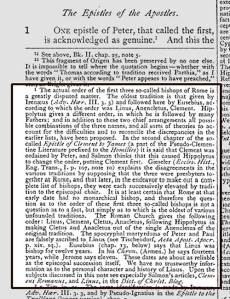Indeed we must believe with a blind faith that the pure motivations of those who ruled the newly organized church weren’t susceptible to normal human failings that included greed, need for power, and the greatest motivator of all within religious circles: fear. For without fear, religion simply cannot exist.
Not surprisingly then, the entire papacy tradition is now being held on very unstable ground. In the Nicene and Post-Nicene Fathers (edited by Philip Schaff and Henry Wace in 1995) we find a footnote — associated with Euseibus’ Church History in regards to the first three bishops of Rome — that adequately reflects this suspicion.
“The actual order of the first three so-called bishops of Rome is a greatly disputed matter. The oldest tradition is that given by Irenaeus (Adv. Haer. III. 3. 3) and followed here by Eusebius, according to which the order was Linus, Anencletus, Clement. Hippolytus gives a different order, in which he is followed by many Fathers; and in addition to these two chief arrangements all possible combinations of the three names, and all sorts of theories to account for the difficulties and to reconcile the discrepancies in the earlier lists, have been proposed. In the second chapter of the so-called Epistle of Clement to James (a part of the Pseudo-Clementine Literature prefixed to the Homilies) it is said that Clement was ordained by Peter, and Salmon thinks that this caused Hippolytus to change the order, putting Clement first. Gieseler (Eccles. Hist., Eng. Trans., I. p. 107, note 10) explains the disagreements in the various traditions by supposing that the three were presbyters together at Rome, and that later, in the endeavor to make out a complete list of bishops, they were each successively elevated by tradition to the episcopal chair.
It is at least certain that Rome at that early date had no monarchical bishop, and therefore the question as to the order of these first three so-called bishops is not a question as to a fact, but simply as to which is the oldest of various unfounded traditions.
The Roman Church gives the following order: Linus, Clement, Cletus, Anacletus, following Hippolytus in making Cletus and Anacletus out of the single Anencletus of the original tradition. The apocryphal martyrdoms of Peter and Paul are falsely ascribed to Linus (see Tischendorf, Acta Apost. Apocr. p xix. sq.).
Eusebius (chap. 13, below) says that Linus was bishop for twelve years. In his Chron. (Armen.) he says fourteen years, while Jerome says eleven. These dates are about as reliable as the episcopal succession itself. We have no trustworthy information as to the personal character and history of Linus. Upon the subjects discussed in this note see especially Salmon’s articles, Clemens Romanus, and Linus, in the Dict. of Christ. Biog. (1)
Rather than spend more time debating the legitimacy of Apostolic Succession, let’s take a closer look at the prevailing concerns and beliefs of the early church fathers and those who “led” the church throughout the first several hundred years. As motivations are made clear, perhaps we will gain a new interpretation to Paul’s words,
“For I now this, that after my departure savage wolves will come in among you, not sparing the flock” (Acts 20:29 – NKJV).
How ironic is it that the fear borne within the Christian community from these very words, would prove to open the door and pave an easy pathway for wolves to undisputedly rule the Christian world for many generations future.
___________________________
Next up: The Apostolic Church — AD 30-100
If new to this blog, begin here to read subject sequentially.
.
.
___________________________________________________________
Footnote References:
(1) Eusebuis, The Church History of Eusebuis, NPNF2-01 Eusebuis Pamphilius: III. 3. 2
(Footnote on Linus No. 1)
.
.
.
.
.
.
.

